how to draw a dog for kids
Dogs are cute! Who hasn't taken a moment to doodle their favorite pooch on the side of their newspaper before? Just like many animals, dogs tin be hard to draw well, especially from retentiveness. If you are trying to up your drawing skill, this guide for how to draw a dog is for you! Nosotros'll cover all the basics of learning to describe animals and dogs in particular, and walk you through cartoon a dog step by pace. Cartoon animals can be really challenging! Living creatures are often harder to draw than static objects, equally you want your animal drawings to be full of life. Here's a few tips to get you started! Information technology might feel like cheating to use a reference, but it's a-OK. Professional artists use references all the time to assistance their artwork experience more realistic. A reference photo will help you run across what a dog looks similar without trying to make a real canis familiaris sit yet the entire time y'all're working. There are so many kinds of dogs that information technology's practically impossible to call up how to draw all of them. Fifty-fifty if they have similar skeletal structures (which isn't ever the case), their fur texture, eye shape, and size tin can vary pretty widely. Yous can take your ain reference photos or use ones you find in books or online to aid you get the details right. Y'all don't have to go to veterinary schoolhouse, but spending some time looking at creature anatomy will help you better understand how an animal sits, stands, and moves. Pay particular attending to the location of the spine, as this will help you effigy out how the animal is shaped. When yous know that, you lot'll accept an easier time positioning the caput, legs, and tails appropriately. You can also become a better handle on their musculus construction, which is especially helpful when drawing animals with short fur and pronounced muscles. Though you don't need to replicate every item in your drawing, understanding how an animal'due south torso works can make your drawings feel more lifelike, even in a cartoony style. Even complicated drawings are based on uncomplicated shapes. A light underdrawing that consists primarily of primary shapes is a keen foundation for more detailed drawings; you lot tin build on the basic shapes to assistance your drawing feel lifelike. Look at an creature's anatomy and imagine it as several continued shapes. You might see a large oval for the ribcage and a rounded rectangle for the head, or an nigh kidney edible bean-like shape for an animal's leg. These are simply guidelines—they'll demand refinement to really work in a cartoon, but using these shapes to guide your piece of work volition help yous stay on track as you're cartoon. It takes fourth dimension and effort to draw well. Start off with light pencil for sketching, and don't be afraid to erase and try again. Equally you progress through the cartoon procedure, you can erase your guidelines and draw in heavier pencil. This helps keep you on target and gets rid of the unnecessary lines. When you're ready, y'all can become dorsum over your drawing in ink or marking, and erase the pencil marks entirely. That ensures that only the lines you lot want are visible! This also works for digital analogy. Using layers in illustration programs, you tin have underdrawings and layers of increasing detail, which tin be turned off when you no longer demand them. With practise, you lot'll soon exist doing manner better than this. Even when you lot're drawing a simple dog, information technology's smart to have an understanding of basic dog anatomy. It might sound silly or unnecessary, but fifty-fifty cartoony drawings demand to be based in reality to await right. Every bit mentioned above, take some time to look at domestic dog anatomy and learn the basic shapes that make a canis familiaris up to help you brand fifty-fifty a simple canis familiaris expect swell! Considering there are and then many kinds of dogs, we can't provide a tutorial for how to draw all of them. Instead, here's a simple guide for drawing a sitting domestic dog that can be adjusted depending on what kind of dog you're drawing. All you need is an oval to offset with. Don't get caught up in making information technology await perfect—you tin can brand adjustments to it later. Also, don't worry about details. Just become a circle downwards and we'll add to it later on, once we take the torso done. Sketch the shape of the head effectually the oval you've drawn for the muzzle. Once again, it doesn't have to exist perfect, because you can change it at any time. Y'all can change the shape depending on how yous want your domestic dog to expect. Some dogs have very round heads while others are more angular, but having the head oval in place gives you a structure to work effectually. Dog noses are unusually shaped. They actually expect a fleck like mushroom slices, with an exaggerated flare at the lesser. You can start past drawing a sort of rounded triangle, then calculation the nostrils to flesh information technology out. A simple nose or a detailed one tin be equally constructive depending on how detailed your drawing is. A domestic dog's ears can be a great source of expression! Depending on what kind of domestic dog you're drawing, the ears may be floppy, upright, or even cropped. Start with the bones shape and tweak information technology from in that location. Let's keep it simple here—optics are tricky to depict well! Two little ovals volition practice the job for now, and so if we're doing a simple cartoony drawing, nosotros don't have to get very detailed. You can add eyebrows to give your domestic dog more than of an expression. Dogs don't take eyebrows exactly like we do, but some have countenance-like markings just above their eyes. Experience free to use your imagination! Okay, it's definitely a dog now. Dogs have two rounded shapes beneath their noses that often plow upwards, making information technology await every bit though they're grin. You lot tin can draw these shapes as rounded ovals to make the canis familiaris look happier, or brand them more athwart and pointed down to make your canis familiaris look more serious. In combination with the ears, the canis familiaris'south mouth is the best way to convey emotion. The body looks a bit like an egg, with the top hidden behind the dog's head. Again, draw information technology lightly and go over it later to add more detail. These legs leave something to be desired. Depict 2 straight lines and add a little oval at the end for the paw. Yous can embellish these with spots or fur, merely the bones shape is just two sets of two lines with a little oval at the end. I wanted a husky-like tail, even if it looks a scrap similar a banana right now. What kind of tail a canis familiaris has depends on its breed. Yous can draw a skinny tail, a fluffy one, or no tail at all depending on what kind of dog you lot're drawing. Dorsum legs are a little more difficult to visualize, but recall back to the anatomy of a domestic dog. The canis familiaris'south thigh is kind of like a tilted oval, and the human foot and lower leg are like an elongated, squashed oval. All these are just sketch lines, so if they await a little funky at present, that'due south okay—you can fix them up with item later on. Details and ink definitely assist the doggy appearance. At present that you take the basic structure of your dog, yous can impact things upwardly with detail, erase all your sketch lines, and outline in ink. Some things to add to make your dog expect more lifelike and cute are colour, fur textures, and whiskers. Take a look at real dogs and run into the features that make them unique, and so make adjustments to yours to make it look special, too! Drawing a detailed canis familiaris is a lot like drawing a simple dog, though it will likely have y'all more time and effort. Over again, sympathise the uncomplicated shapes that make up a dog. Look at skeletal structure and musculus groups to help you understand what they wait like nether all that fur, as those are the features you'll start with before you add more detail. Offset and foremost: start elementary. Information technology's easier to draw a familiar yellow lab than it is to draw something more than complex, like a Puli. That goes for shapes, too. Underdrawing is even more important when cartoon detailed dogs than it is for simple dogs, even if yous feel like yous're erasing virtually of the work. And erasing is a big part of drawing detailed dogs. You probably won't become it perfect the first time, only that's okay! The dog up to a higher place was my beginning attempt, and if I connected to practice I would go improve. Erase and attempt once again and again. You might not notice your skill improving, but every cartoon y'all do brings you closer to the artist y'all desire to be. You can use your own photo or one yous find online, simply add your own embellishments and tweaks to really make it your own. You don't need to trace, though you can if you're just starting out and want to get a better grasp on what dogs wait similar. It's not incorrect to learn by tracing, but it's a good thought to use those drawings equally practice unless you took the photograph yourself. Many artists take their own reference photos. If y'all can't, y'all can use one you find online, but aim to make your drawing substantially dissimilar from the reference if you lot plan to apply the picture for something other than practice. Starting with a reference photo lets you work off of an existing paradigm, which can help your drawing be more authentic. Use what you know of skeletal construction so you tin better draw the shapes that make up a canis familiaris. Naturally, dogs are made up of many complex parts. But when you're starting your cartoon, but focus on the nuts—the shapes that make up the basic form of a domestic dog. If you were to but imagine a dog'southward silhouette, yous might run into a rounded rectangle for the head, a large oval of the chest, and another oval for the hindquarters. Offset with a line to continue the body parts aligned. The line can be straight or slightly curved, depending on what position you'll draw the dog in. Then draw the basic shapes at their appropriate places, centering them on the line. Now that you have the bones dog shape down, yous can add just a petty more detail. Focus on drawing the larger features of a canis familiaris—the snout, feet, and legs. Again, draw shapes rather than detailed features, equally you'll add all the picayune stuff subsequently. Fill in the places where those features meet the body, and connect the larger sections of the torso together. You lot'll mankind all of this out later on; for now, you just want it to look like the basic silhouette of a domestic dog, not something instantly recognizable as whatever breed of dog you lot're trying to depict. At present's the time to start getting into item, generally in the body. Add together some rough structure to the trunk, such as muscle definition for short-haired dogs or fur outlines for long-haired dogs. Look at where the brood is thicker or thinner, and emphasize those areas of the body. Look at where fur gathers on images of the type of dog yous're cartoon, and likewise where muscles are more visible. Those are the areas to emphasize hither, but, as always, don't get too invested in details nonetheless. Also take a moment to describe the legs and feet in more detail. Add toes and fur, if necessary, so you have a clearer picture of what the terminal canis familiaris will look similar. Get rid of the guidelines yous used, equally from now on you'll mostly exist fleshing out details and shading. Yous've spent enough time on the basic shape, adding some fur and details, that y'all no longer demand your initial shapes and guidelines. At present's the time to add basic outlines for the dog's ears, eyes, nose, and snout details. Become their placement and shape right, and be sure they look similar to those in your reference photo. This will probably take some time. Don't get frustrated if you have to draw and redraw these features several times—these are details that are important to get right, only that can exist quite tricky to execute well. You might accept to exercise a lot of practice, but it'll be worth it in the end! At present yous can add fur and fluff to the details you added in the final step. Add a picayune fur to the ears or petty tufts on the legs. If you're not drawing a particularly shaggy dog, add together more muscle definition. Utilise shading to emphasize where the dog'southward muscles would show, and sketch out areas where the dog is more than muscular to make it look more realistic. Only as yous've washed throughout the cartoon, outset with general details earlier y'all get into the smaller ones. Become for general fur shape, then add fuzzier patches. Get the full general body shape and muscle construction done, and so add muscles that are in utilize given your reference photograph's pose. Information technology'due south not perfect, merely that just ways it's time to practice! You lot're almost done! Take some time to add together additional details to things like the domestic dog's olfactory organ and optics, and add teeth or a tongue depending on whether the canis familiaris's mouth is open. You can also add spots or other color patterns if your dog has them. Merely shading will attain this, or you can employ full color to give your moving picture even more pop. However, it is possible to get also detailed. Some artists draw intensely detailed images while others are a little more sparing. Both are dandy art styles, so don't experience similar adding tons of detail is the only mode to make your art look realistic and interesting! Once you've got the basics downwardly, drawing a dog is a matter of practice. Go along trying to improve, even when it feels like your skill isn't getting better. But if you need some additional assist in drawing certain parts or certain kinds of dogs, consider these tips! Drawing a canis familiaris'south confront can be especially tricky—nosotros want our drawing'due south faces to exist as expressive and cute as real dogs. Understanding what a dog's skull is like is a keen first step, every bit you'll be able to see what parts movement, what parts don't, and where important features similar the ears and eyes sit. Outline the bones shape before calculation features. You can block them in using lines to be sure that they're all aligned properly. As with the rest of the canis familiaris, outset with the broader details and and then fill in the specific ones. First with the shape of the optics, for example, and refine them until they look right. Then add the iris and pupils every bit well every bit surrounding fur. You tin can always brand changes, but it'southward easier to start with the larger details and fill in the specific ones than end up having the erase everything because you can't become the shape to look right after you've fatigued the details. Puppies are a lot more than miniature dogs—they have different features, which means at that place are special considerations to keep in mind when cartoon them as opposed to adult dogs. For ane, puppies ofttimes take proportionally larger paws than developed dogs. Drawing the paws a flake larger is a skilful way to clue people into the fact that you're drawing a puppy! Puppies are also generally a little chubbier, with more rounded bodies. Though some might be a lilliputian muscular, for the almost part puppies will be more than rounded—combined with other puppy features like larger paws, a rounded trunk can brand a dog await younger. Some breeds also have gangly legs, peculiarly as they begin to abound into adolescents. A few adult breeds, such equally borzois and greyhounds, may look gangly as adults, only many dogs get that same look as they're growing upward. Information technology's okay to make your puppy drawings look a niggling awkward—information technology's true to life! Another practiced detail for puppies is that their eyes often await proportionally larger than those of developed dogs. This is a common characteristic of baby animals, and information technology's part of the reason that people dear them so much. A large head, round optics, and smaller nose and mouth remind us a lot of man babies, so utilise those features to make your puppy drawings expect even cuter! Don't exist afraid to experiment with different styles when cartoon dogs. Check out this guide to how to do profile line art and attempt out a whole new art direction! Not sure what to draw now that y'all've mastered dogs? This list of 100 different drawing ideas is sure to help. Cartoon is a great hobby, merely it tin likewise brand you coin. Bank check out this list of art scholarships to aid yous turn your skills into cash for higher!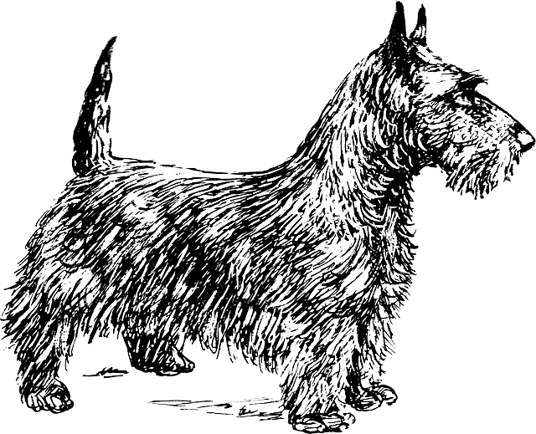
4 General Tips for Drawing Dogs and Animals
Use References
Written report Anatomy
Start With Simple Shapes
Draw Lightly
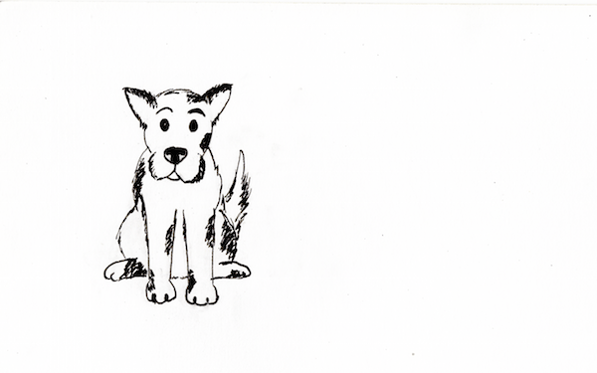
How to Describe a Dog: The Simple Method
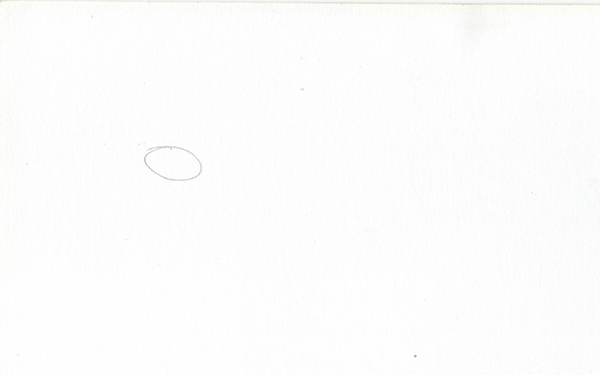 A modest beginning.
A modest beginning. Sketch the Muzzle
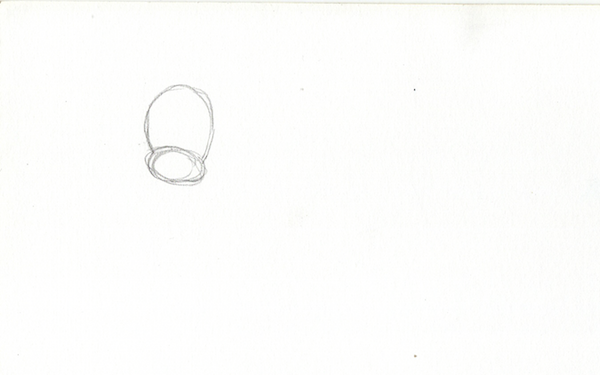 It doesn't expect like much yet...
It doesn't expect like much yet... Draw the Head
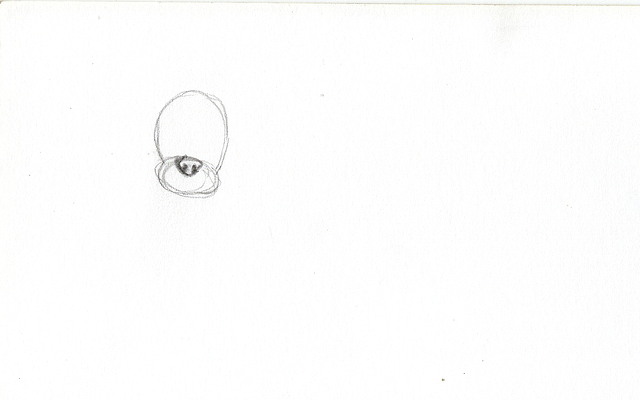 Looking a chip more like a dog now.
Looking a chip more like a dog now. Add a Olfactory organ
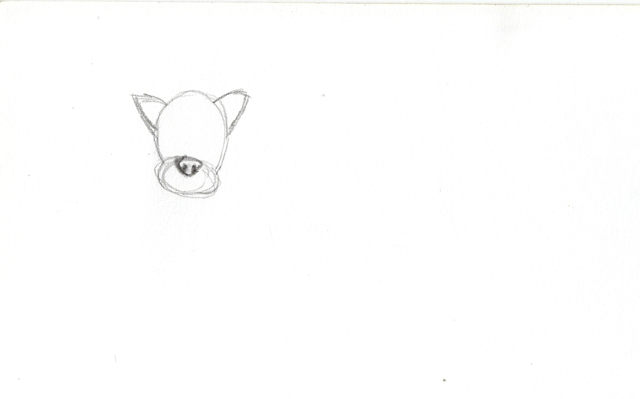 Making progress...
Making progress... Add together Ears
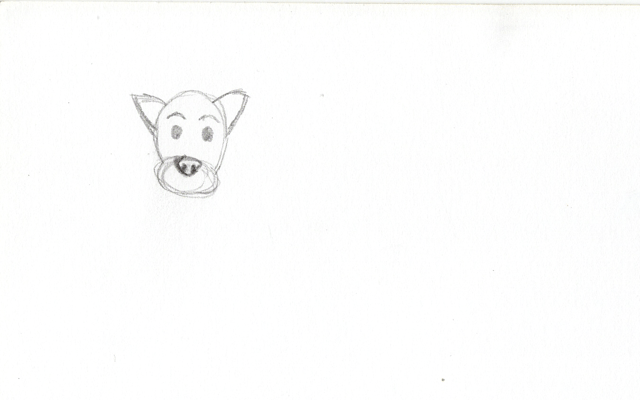 Optics make a big difference.
Optics make a big difference. Add together Eyes
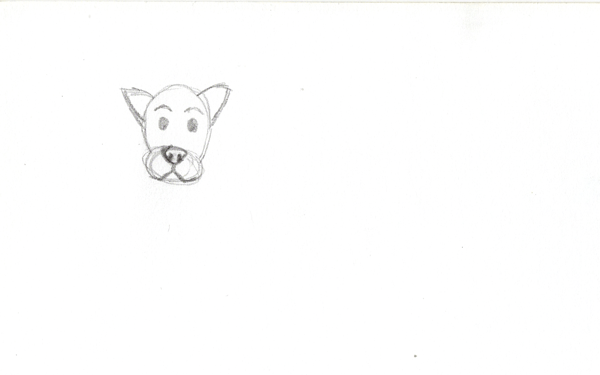
Add a Mouth
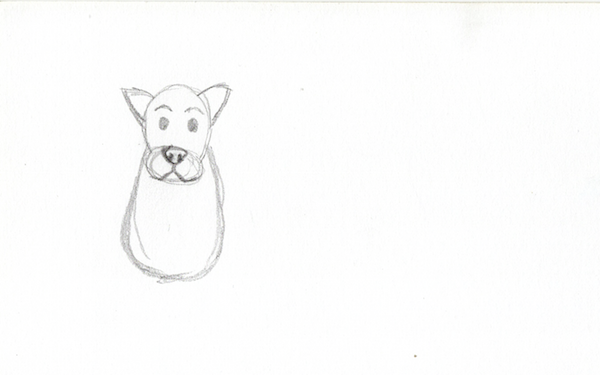 The egg-shaped body feels like a bit of a step backward.
The egg-shaped body feels like a bit of a step backward. Add a Torso
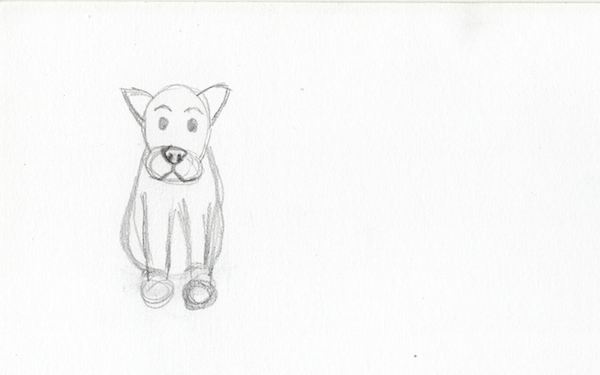
Add Forepart Legs
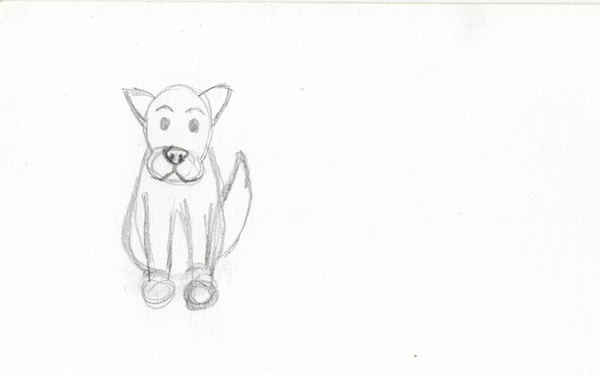
Add a Tail
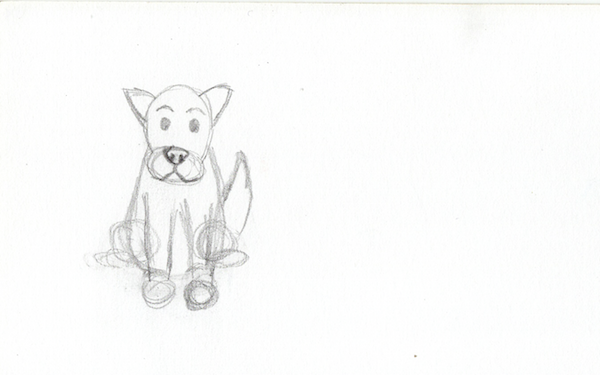 These legs are a little on the abstract side.
These legs are a little on the abstract side. Add together Back Legs
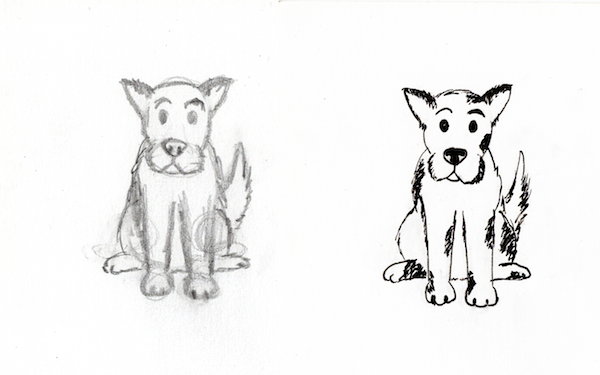
Add Details and Terminate Up
How to Draw a Canis familiaris: The Detailed Method
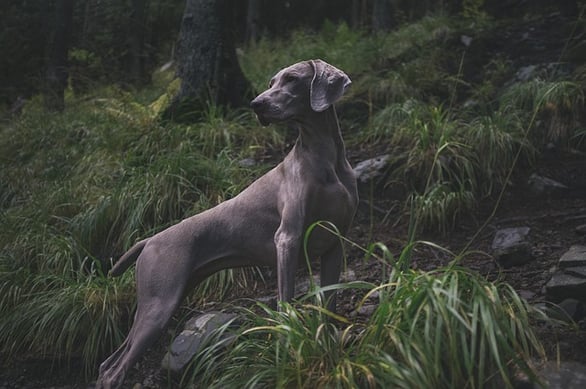 This beautiful dog is going to exist our reference photo.
This beautiful dog is going to exist our reference photo. Start With a Reference
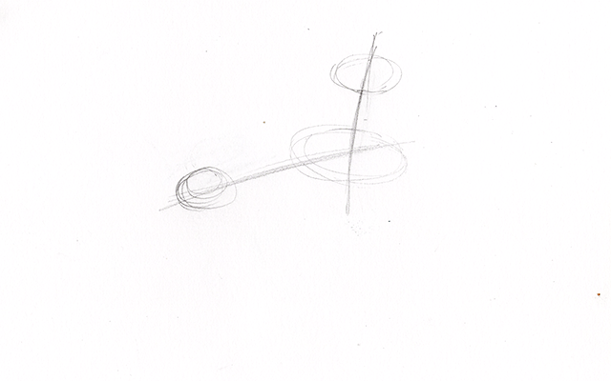 Not very impressive.
Not very impressive. Outline Shapes
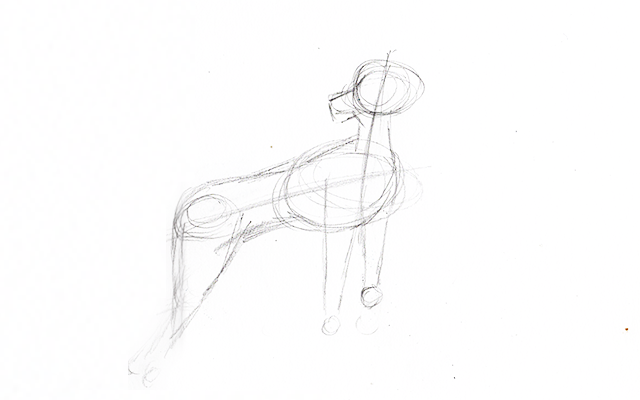 After some redrawing, we take the basic form of the dog in our photo.
After some redrawing, we take the basic form of the dog in our photo. Outline Shapes for Larger Features
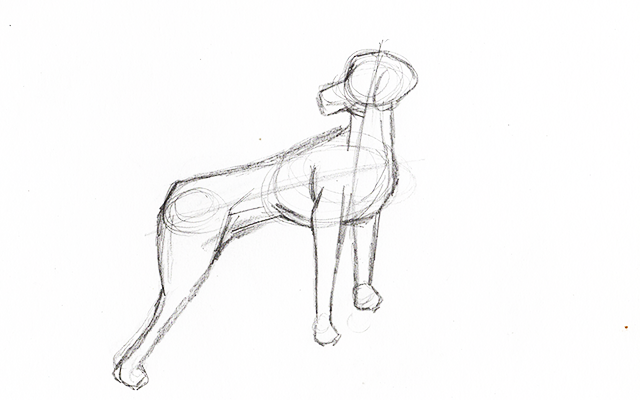 This dog is more muscular than furry, and then I focused on the muscles.
This dog is more muscular than furry, and then I focused on the muscles. Add together Trunk Contour
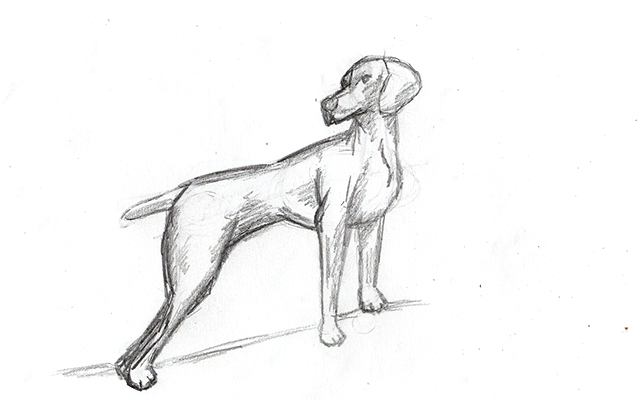 Hey, that's a canis familiaris!
Hey, that's a canis familiaris! Erase Unnecessary Lines
Add Fur Texture
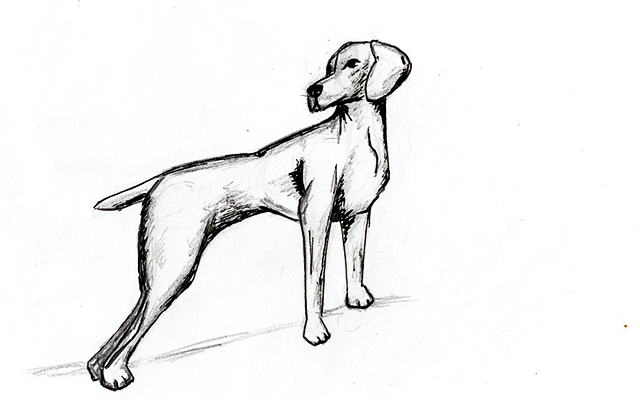
Finishing Touches
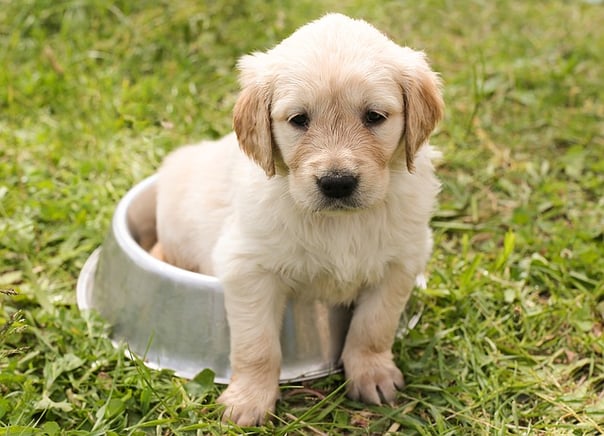
Additional Tips for Drawing Dogs
How To Depict a Dog's Face
How to Draw a Puppy
What'south Side by side?

About the Writer
Melissa Brinks graduated from the University of Washington in 2022 with a Bachelor'south in English with a artistic writing emphasis. She has spent several years tutoring K-12 students in many subjects, including in Sat prep, to help them ready for their higher education.
Source: https://blog.prepscholar.com/how-to-draw-a-dog
Posted by: howardsciallsolle.blogspot.com


0 Response to "how to draw a dog for kids"
Post a Comment